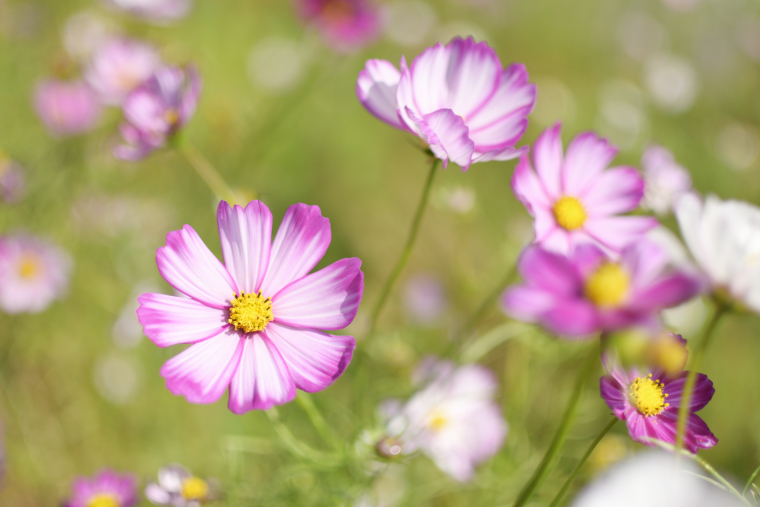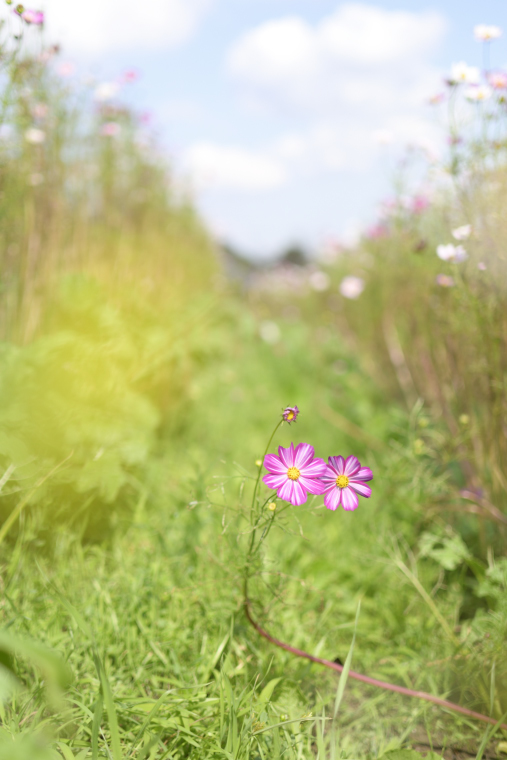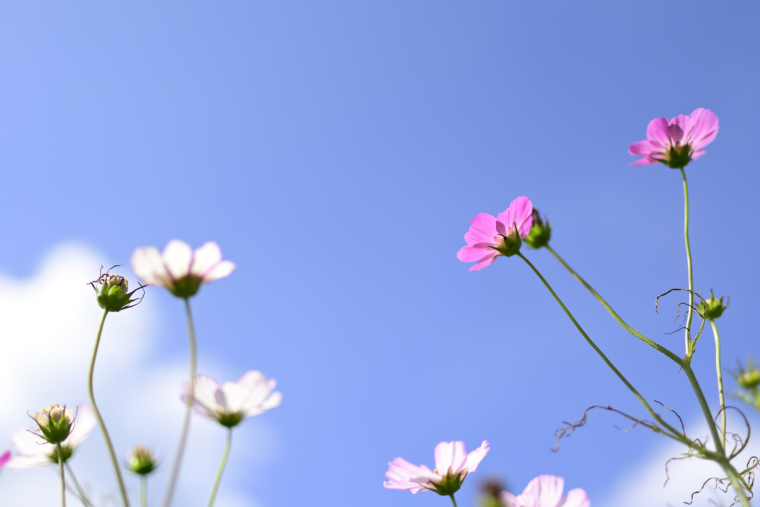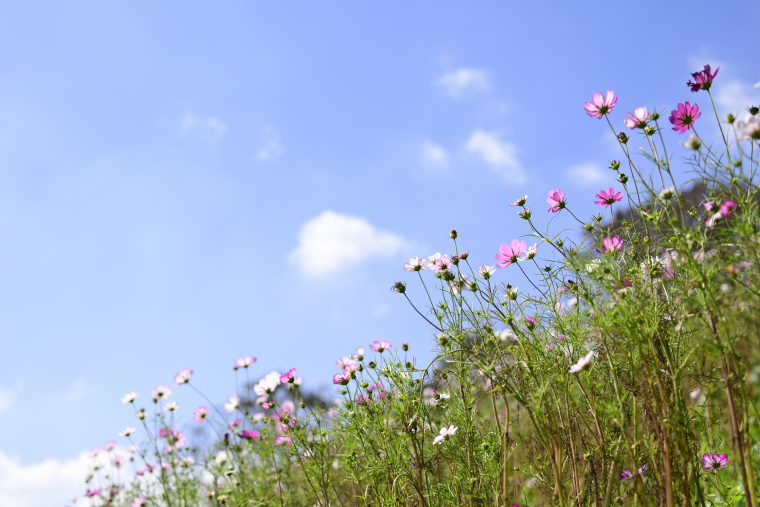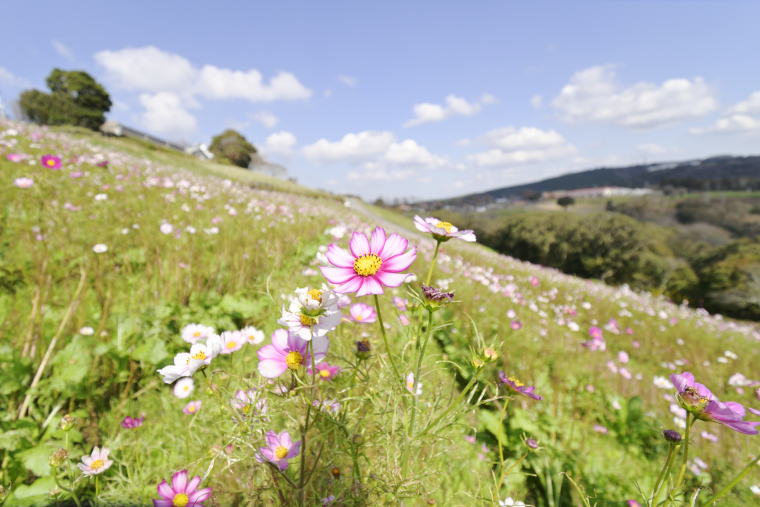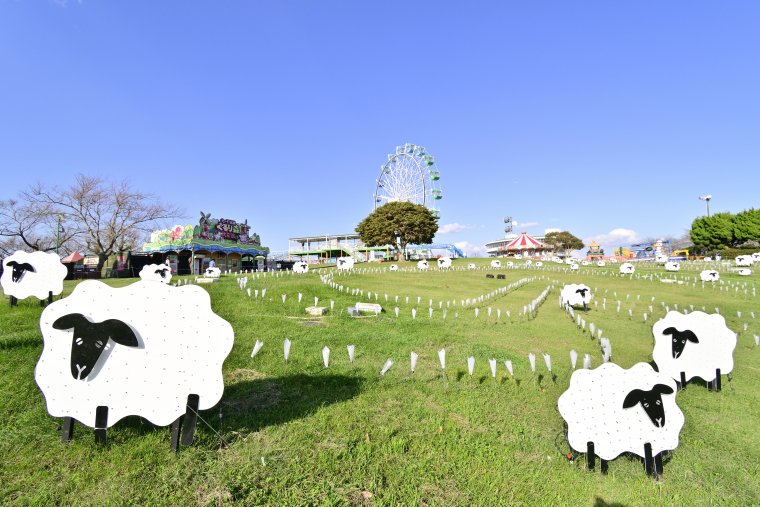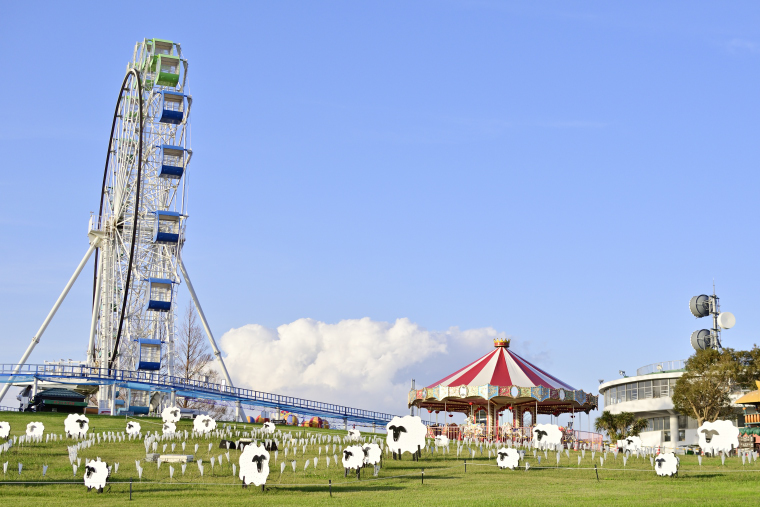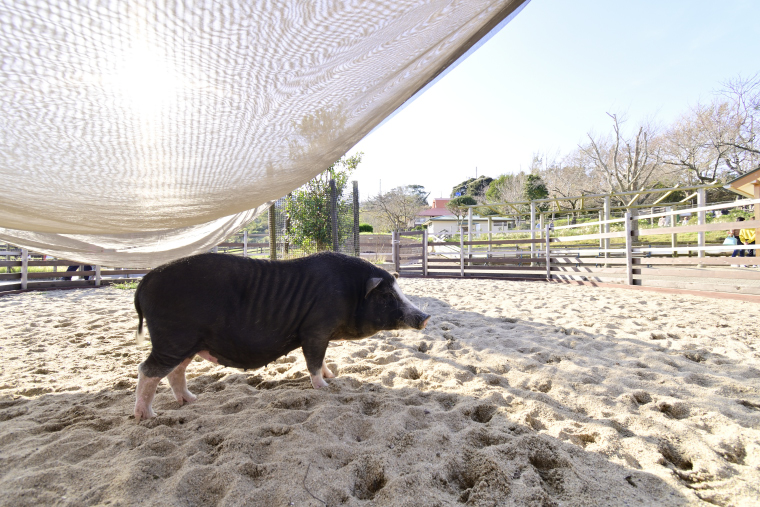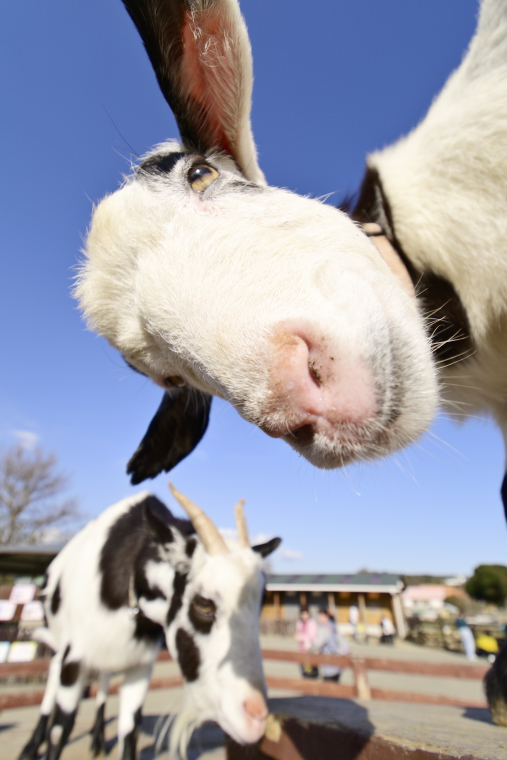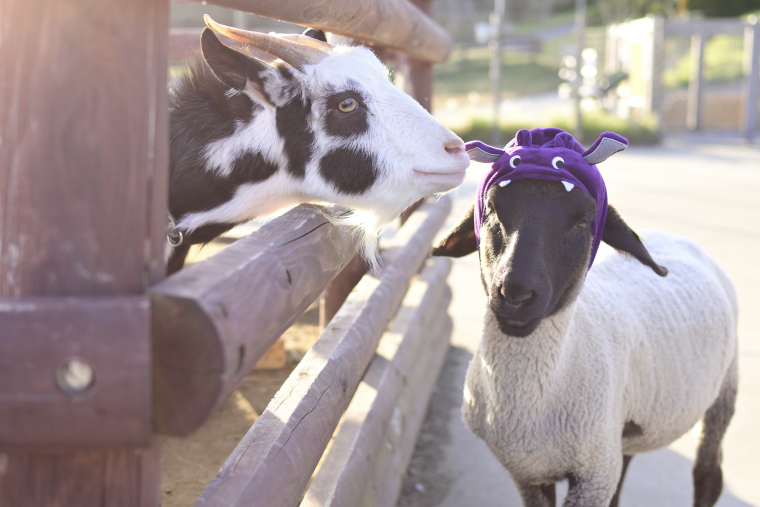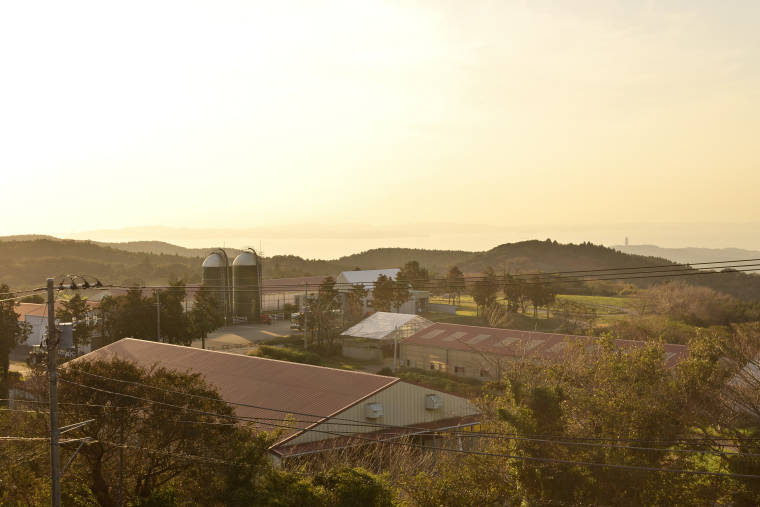35 mm/Wide-Angle Zoom Lenses—Flowers and Farmyards
Photos/Text: Yuki Mizota
Photographing Flowers
I
had come hoping the cosmos were in full bloom, only to find that many had finished
blooming, leaving noticeable gaps between the flowers. And while from a distance the
field was still beautiful, a closer look revealed areas of wilted blossoms. Having
brought only a 35 mm prime lens and a 10–20 mm wide-angle zoom lens,
I concentrated on getting as close as possible to the prettiest blossoms.
Knowing that a bird’s-eye view would reveal wilted blossoms and the earth beneath,
I choose a low f/-number (large aperture) to blur these details as much as possible.
The farther the camera is from the main subject, the more the flowers in the background
blur, reducing them to smears of color. In addition to making your subject stand out,
background blur can be effective in concealing objects you’d rather not reveal.
(When I say “subject”, I mean the thing the photograph is of, in this
case, the cosmos flowers.) One technique is to choose the color of the background
according to your subject (Sample Photo 1).
I found a cosmos blooming at
my feet some distance from the others. It was so close I almost trampled it, but it
seemed healthier than the other blossoms. Because a composition that would show the
surroundings would make the flower appear small, I framed the shot with yellow cosmos
between my subject and the lens to create some foreground blur. Placing my subject
between blurred flowers in the foreground and background helped increase a sense of
lightness and space (Sample Photo 2).
Here’s a pretty shot showcasing the pastel colors of the pink cosmos and blue sky, taken just as a cloud as fluffy as cotton candy was drifting by. Note how the sunlight makes the petals appear translucent (Sample Photo 3).
The slope of the hillside cosmos field lent itself to a diagonal composition in which the flowers seem to strive toward the blue vault of heaven. Even when the flowers are small, it is important to choose a pretty blossom as your main subject (Sample Photo 4).
The effect created by a 35 mm lens varies with your distance from the subject.
Close-ups create an impressionistic image or effect, while long shots give viewers
some idea of the surroundings. You will likely find it easier to choose a position
and frame the shot if you stop first to picture which of these effects you want.
Composing shots with a wide-angle zoom lens poses a knotty problem: somehow,
the greater the distance, the more evident the gaps between the blossoms, while the
closer you are, the more the wilted blossoms stand out. The key is to note how the
background looks when framing closeups of good-looking blossoms. Search for the best
position while looking through the viewfinder and changing the height and angle a
little at a time (Sample Photo 5).
I find it entertaining to change compositions according to the lens, using a 35 mm
lens to blur backgrounds and foregrounds and a wide-angle zoom lens to get close to
my subject while using the wide angle to emphasize the effects of perspective.
Cute, Laid-Back Farmyard Shots
When I visited Mother Farm for this shoot, the weather was clear and the blue
sky stretched in every direction. The farmyard was home to familiar animals such as
sheep and pigs. Feeling the effects of the relaxed atmosphere, I took “freedom”
as my watchword and roamed abroad taking photographs with a 35 mm lens that made
it easy to record subjects just as I saw them and a wide-angle zoom lens that gave
me a wide view of their surroundings.
I took Sample Photos 6 and 7 respectively with a wide-angle zoom lens at a focal length
of 10 mm and with a 35 mm prime lens. The differences between the lenses
are readily apparent, notwithstanding the fact that the photos were taken from different
positions at different times of day. Having been charmed by the cutout of a sheep,
I wanted to approach fairly near for a closeup while still showing the full extent
of its surroundings, so I choose the wide-angle lens. In the other photograph I was
aiming to capture the rhythmical pattern of the sheep together with the fluffy cloud
in the blue sky, so I chose the 35 mm lens. If you picture the results you want
in advance you’ll find yourself naturally selecting the correct lens (Sample
Photos 6 and 7).
Animals seem to prefer cool, shady locations on hot, bright
days. The sight of this pig seeking refuge from the sun under the shelter of a mosquito
net was too cute for words. Given that a composition that included only the pig would
make it seem as though the animal were just standing in a sandlot, I naturally felt
that including the surroundings in a wide-angle shot would better communicate what
made the scene interesting. The best angle was a low one that would help the viewer
identify with the pig. An accent is added by the footprints in the sand (Sample Photo
8).
A short while later it was time for the piglet races. Anticipating that the children would be chasing the pigs, I set focus to AF-C, the AF-area mode to 3D-tracking, and chose continuous release mode. When tracking motion, choose settings that let the camera track the subject and then just concentrate on choosing the right moment for the shot. A moment that with tight framing would seem tense and dynamic is here framed in a wide shot to make it seem relaxed and fun. The shadows in the foreground belong to the spectators: by choosing a wide angle to capture the surroundings, I was able to hint at the presence of the audience (Sample Photo 9).
A goat kindly stopped to peer into the lens while I was photographing it in the farmyard at what must have been close to the minimum focus distance. It was even so obliging as to look directly at the camera. With the light behind me I had only to ensure I didn’t cast a shadow on the goat’s face; after that, it was just a matter of seizing my chance. The distortion produced by the wide angle lends the goat a uniquely entertaining expression. The cuteness is enhanced by the catch light in the goat’s eye (Sample Photo 10).
While the direct lighting in Sample Photo 10 lends the animal’s coat a healthy look, with the colors standing out clearly, back lighting this pair of goats reduces contrast for heartwarming results. Instead of the overly distorted results that would be produced with a wide-angle lens, the natural rendering produced by the 35 mm lens is perfect for this scene. Because the scene was back lit, I raised exposure compensation so that the goats’ expressions would be visible (Sample Photo 11).
Before I knew it, the sun had begun to set. I took this shot with white balance set to “shade” to lend the moment an artistic effect. The “shade” setting creates a romantic effect by making colors more saturated than “direct sunlight” (Sample Photo 12).
One intuitively experiences the passage of time and changes in lighting when spending
a whole day on a farm taking photos. I feel I was able to get fun photos, peaceful
photos, and whole range of different kinds of photos while choosing lenses and lighting
according to the timing and setting in which I encountered the animals.
Note: Visitors to Mother Farm are prohibited from picking or otherwise damaging
the plants. Visitors are permitted to enter the hillside cosmos field for a closer
view, but please show respect for others when taking photographs.
Tips: Taking Snapshots with
a Standard Prime Lens
Tips: Taking Snapshots of
Street Scenes with a Standard Prime Lens
Tips: Taking Snapshots with
a Wide-Angle Zoom Lens
Tips: 35 mm/Wide-Angle
Zoom Lenses—Street Scenes
Thanks to: Mother Farm


